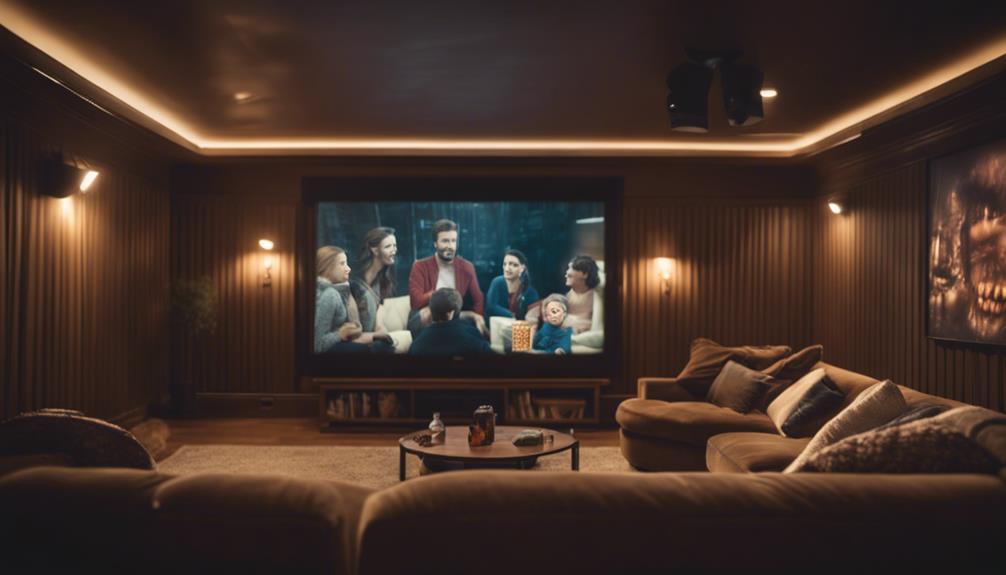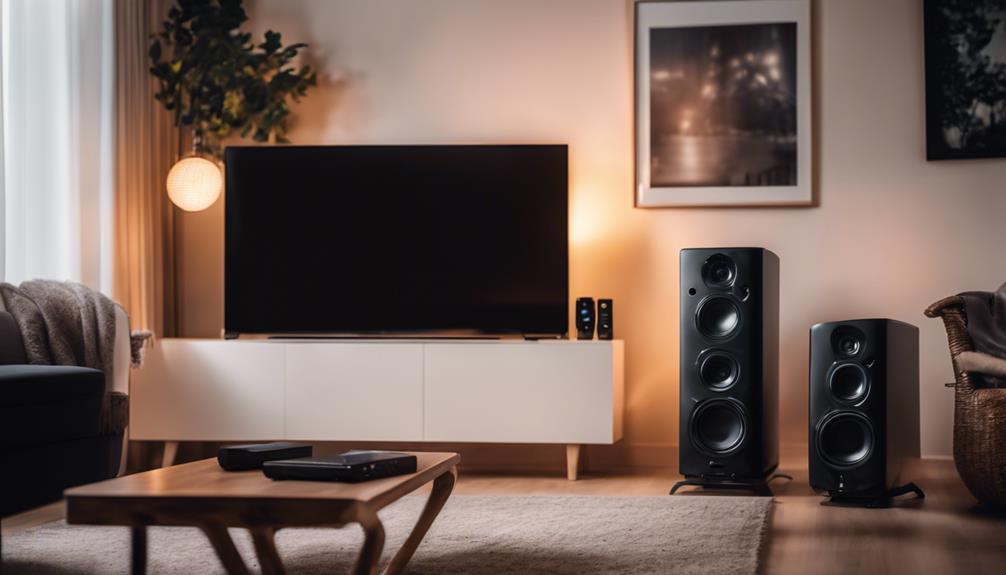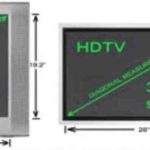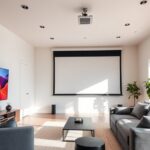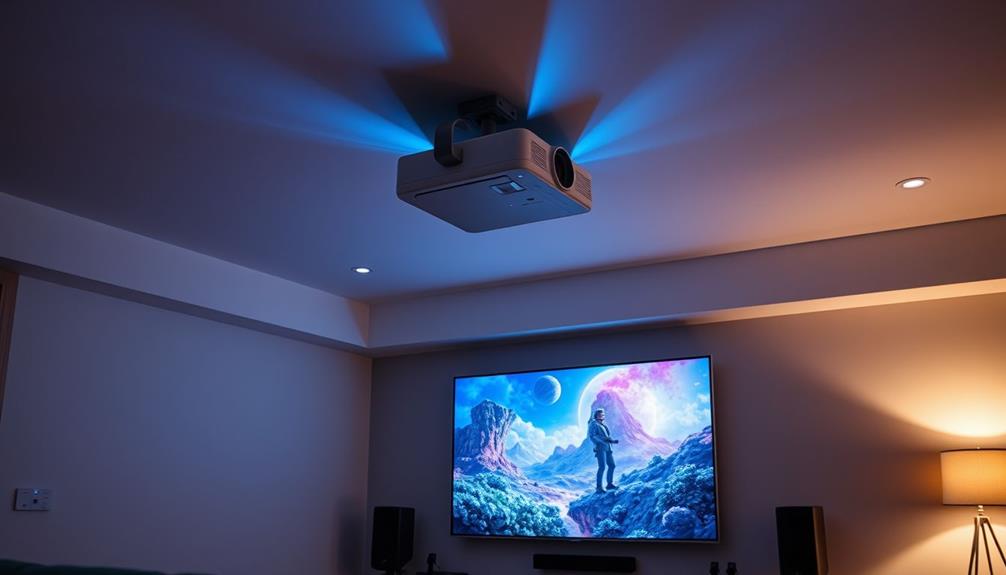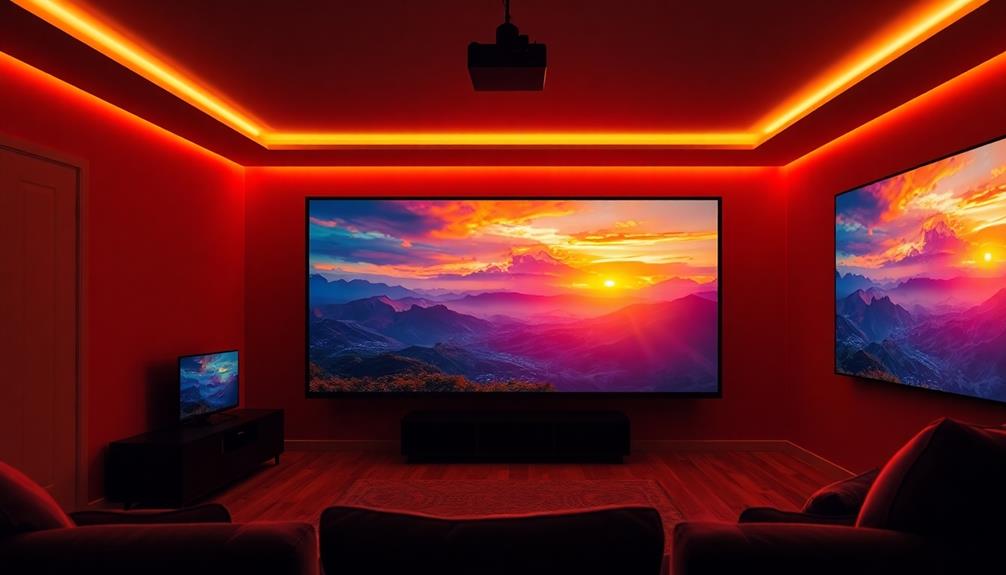Choosing the right screen size for your home cinema is crucial for an immersive experience. Start by measuring your room's depth and divide that by two to find the ideal screen size. For maximum clarity, sit 1.5 to 2.5 times the screen size away. Consider the aspect ratio too; a 16:9 is perfect for TV, while 2.35:1 is great for movies. Make certain your screen material enhances brightness without sacrificing viewing angles. Finally, verify your room layout accommodates the screen for everyone to enjoy. There's much more to explore, so keep going to enhance your home cinema setup even further.
Key Takeaways
- Calculate the ideal screen size by dividing room depth by two and ensuring the viewing distance is 1.5 to 2.5 times the screen size.
- Maintain a 36 to 40-degree field of vision for an immersive viewing experience, aligning the screen size accordingly.
- Choose the aspect ratio based on your content type; 16:9 for TV shows and 2.35:1 for cinematic films.
- Ensure the screen material enhances image quality; matte surfaces are recommended for consistent brightness and minimal reflection.
Importance of Screen Size
Choosing the right screen size is vital for creating an immersive home cinema experience that fully engages your senses. A larger screen size enhances your field of vision, making the cinematic experience more lifelike.
When you select a screen, consider your room dimensions carefully. The general rule of thumb suggests that dividing the room depth by two gives you the ideal diagonal screen size. This balance guarantees you won't strain your eyes or miss details in the image.
Optimal viewing is significant; experts recommend maintaining a viewing distance that's 1.5 to 2.5 times the screen size. This distance enhances image clarity and comfort, allowing you to fully appreciate the stunning visuals.
If your projector technology supports it, a screen size that allows for a 36-degree viewing angle can elevate your experience even further. Remember, larger screens can reveal inconsistencies in lower-resolution sources, so choose high-quality content for the best results.
To conclude, selecting the right screen size not only impacts your visual enjoyment but also transforms your home cinema into an engaging space for unforgettable movie nights.
Understanding Viewing Distance
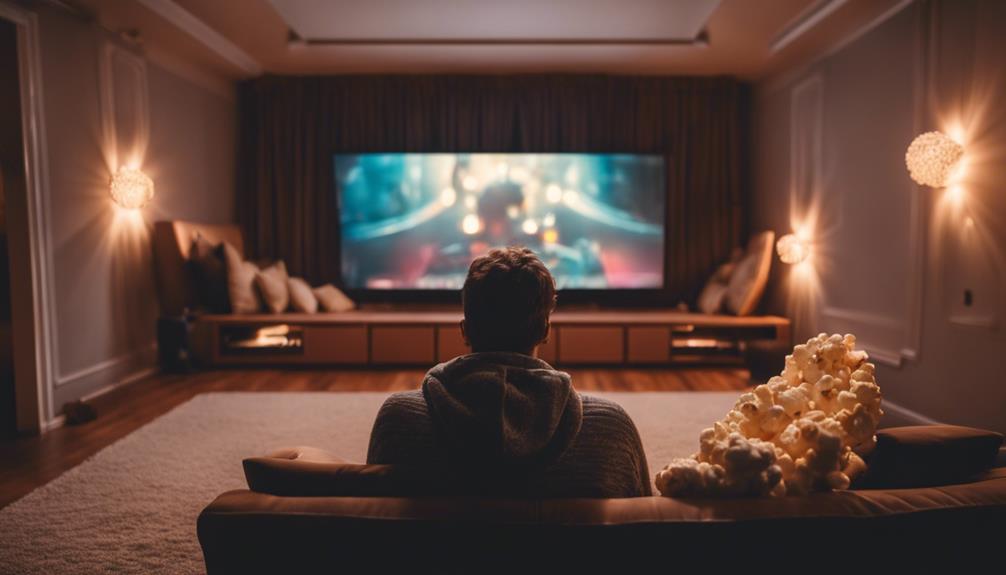
Understanding the right viewing distance can greatly enhance your home cinema experience, ensuring you enjoy every detail without straining your eyes. The recommended viewing distance for a 16:9 screen is approximately 1.5 to 2.5 times the screen size, which guarantees optimal image clarity. For an immersive experience, THX advises maintaining a 40-degree field of vision.
To calculate the ideal screen size, multiply your viewing distance by 0.835 for a 16:9 aspect ratio. This formula helps you determine the best diagonal measurement for your projector screen size. Here's a quick reference table to guide you:
| Viewing Distance (ft) | Ideal Screen Size (in) |
|---|---|
| 6 | 50 |
| 8 | 65 |
| 10 | 80 |
Choosing the Right Aspect Ratio

When setting up your home cinema, choosing the right aspect ratio is essential for an ideal viewing experience.
You'll want to take into account the types of content you'll watch most often, as common ratios like 16:9 and 2.35:1 cater to different formats.
Understanding these ratios can help enhance your enjoyment and clarity of the films and shows you love.
Aspect Ratio Importance
Finding the right aspect ratio is vital, as it shapes how you experience your favorite films and shows. The most common aspect ratio for modern home theaters is 16:9, which is standard for TV shows and provides a cinematic widescreen experience.
However, if you're watching widescreen films, you might encounter a 2.40:1 aspect ratio. This ratio enhances the cinematic experience but can lead to letterboxing on 16:9 screens, affecting your viewing angles and projected image size.
Choosing the right aspect ratio influences how content is framed and perceived, ultimately affecting your overall home theater experience. It's essential to take into account the types of content you'll be watching most frequently. While older 4:3 shows may still hold some relevance, they're largely obsolete in today's media landscape.
If you invest in advanced projectors, you'll benefit from dynamic masking capabilities that automatically adjust the aspect ratio based on the content displayed. This feature optimizes your viewing experience and guarantees you enjoy every film and show as intended, without compromising the image quality or framing.
Make sure to include these elements when choosing your ideal aspect ratio for a truly immersive home cinema experience.
Common Aspect Ratios
Selecting the right aspect ratio involves recognizing the common formats used in home cinema, which can greatly enhance your viewing experience.
The most prevalent aspect ratio for home theaters today is 16:9. This format is ideal for modern television shows and streaming content, delivering a widescreen experience without letterboxing.
However, if you're a fan of cinematic films, you might prefer the 2.35:1 aspect ratio, which offers a wider field of vision that heightens immersion. Just keep in mind that viewing 2.35:1 content on a 16:9 screen may result in black bars.
Older media types often used a 4:3 aspect ratio, which has become less suitable for contemporary home theaters, limiting screen compatibility with current content.
It's crucial to choose the right aspect ratio, as it impacts how content is framed and perceived. Proper alignment contributes considerably to an engaging viewing experience.
Additionally, understanding how advanced projectors utilize masking can help you dynamically adjust aspect ratios, ensuring the best fit for your setup.
Choosing Based on Content
To guarantee an enjoyable viewing experience, match your screen's aspect ratio to the type of content you watch most often. This alignment enhances your overall satisfaction and minimizes issues like letterboxing. Here are some key considerations:
- 16:9 Aspect Ratio: Ideal for most TV shows and streaming content, offering a widescreen experience.
- 2.35:1 Aspect Ratio: Perfect for cinematic films, especially on large screens over 120 inches, enhancing the immersive experience.
- 4:3 Aspect Ratio: Mostly obsolete but may be needed for older TV shows or presentations.
Understanding your content type is essential. If you're primarily watching movies, a larger screen with a 2.35:1 aspect ratio creates an ideal home theater setup. Conversely, if you favor TV shows, a 16:9 screen size will provide a seamless experience.
Screen Material Considerations

When it comes to screen material, you'll want to evaluate the types available and how they affect your viewing experience.
The gain of the material plays a significant role in brightness and viewing angles, so you'll need to find a balance that suits your setup.
Additionally, think about whether you want an acoustic screen or a conventional fabric option to match your projector's specifications and the lighting conditions in your space.
Screen Material Types
What screen material you choose can greatly impact your home cinema experience, making it vital to comprehend the options available. Here are some key factors:
- White Surface: This is the most common material, reflecting light ideally for vibrant colors.
- Gain: This refers to how well a screen reflects light. Higher gain can boost brightness but may compromise viewing angles and image quality.
- Acoustic Screens: Designed to let sound pass through, these screens are perfect for setups with speakers behind them.
When selecting from different screen material types, remember to take your projector specifications into account. The right match is vital for achieving the best possible image quality and enhancing your viewing experience.
For example, if you have a projector that performs best with a matte surface, choosing a glossy screen could lead to disappointing results.
Gain and Viewing Angles
Understanding the gain of your projection screen is key to improving viewing angles and overall image quality in your home cinema setup. Gain measures a screen's ability to reflect light, typically ranging from 1.0 to 2.5. A standard screen with a gain of 1.0 offers a balanced experience, guaranteeing color accuracy and clarity, even for viewers positioned off-axis.
For ideal viewing angles, place your screen at eye level when seated. This helps maintain comfort and clarity. Remember, viewing angles exceeding 40 degrees can distort image quality, so it's crucial to choose the right screen material. A matte finish can help mitigate this distortion by providing wider light dispersion, enhancing your viewing experience.
If you're considering acoustic screens, which allow sound to pass through while maintaining image quality, be mindful of both screen material and speaker placement. Proper selection guarantees that you don't sacrifice sound clarity for visuals.
Ultimately, understanding gain and viewing angles will greatly enhance your home cinema, allowing you to enjoy movies the way they were meant to be seen, with everyone in the room experiencing the same stunning image quality.
Types of Projection Screens

Choosing the right type of projection screen can greatly enhance your home cinema experience, whether you're looking for a fixed frame for a dedicated space or a retractable option for versatility. Here are some types of projection screens to evaluate:
- Fixed Frame Screens: Ideal for dedicated home cinemas, they provide consistent image quality and stability, suitable for darker environments.
- Retractable Screens: Perfect for non-dedicated spaces, these can be mounted on walls or ceilings and concealed when not in use. Tab tensioned options help maintain a flat surface.
- Aspect Ratios: Depending on your content, you might choose 16:9 for most media or 2.35:1 for a more cinematic experience, which can influence your choice of screen.
When selecting your projection screen, confirm that the screen size matches your room dimensions and projector capabilities.
Also, evaluate the minimum viewing distance of 1.2 to 1.6 times the screen size to optimize your viewing experience.
Calculating Ideal Screen Size
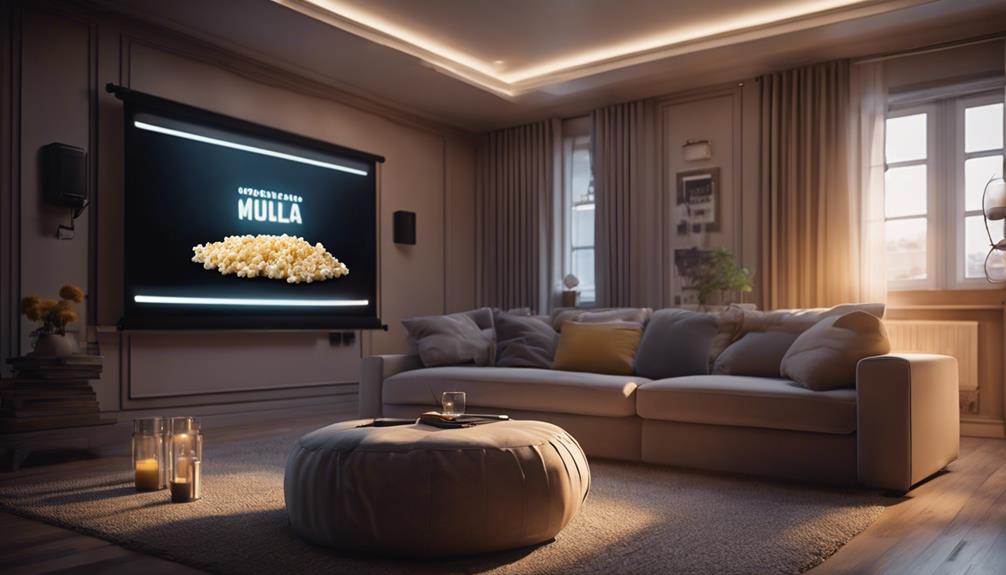
Determining the ideal screen size for your home cinema involves calculating the best viewing distance to enhance your movie-watching experience. Experts recommend that your viewing distance should be between 1.5 to 2.5 times the diagonal screen size.
For a 16:9 aspect ratio screen, you can calculate the recommended screen size by multiplying your viewing distance (in inches) by 0.835. To create an immersive experience, consider the SMPTE guidelines, which suggest a minimum 30-degree field of vision, while THX recommends 40 degrees.
A simple rule of thumb is that your room depth divided by 2 equals the diagonal screen size, allowing you to balance screen size with your room dimensions effectively.
Before making a final decision, the blue tape method is a great way to visualize potential screen sizes in your space. Simply mark out the dimensions on your wall to see how different screen sizes will look.
This hands-on approach helps you assess how the screen size complements your room layout, ensuring you choose a screen that enhances your viewing experience.
Room Dimensions and Layout
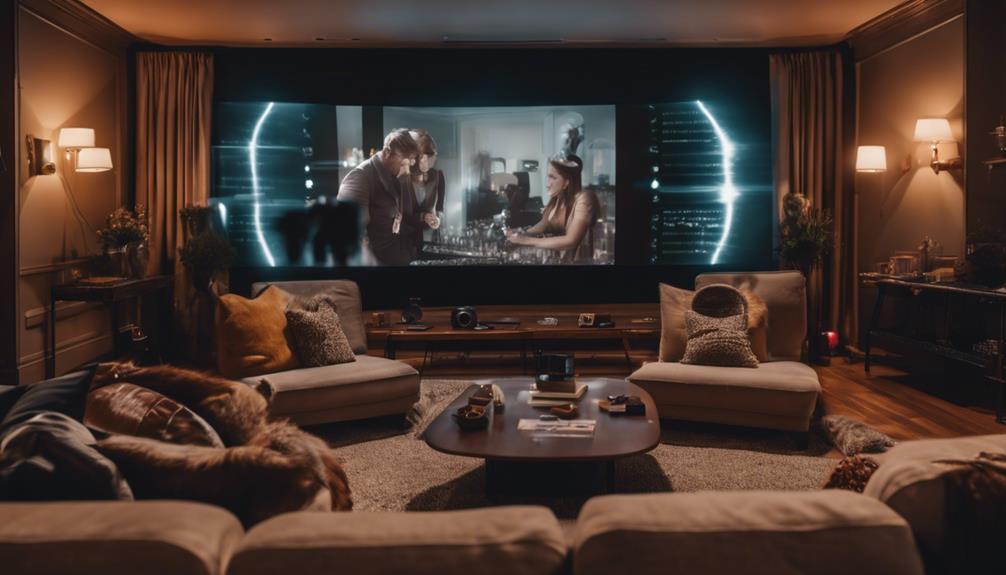
The layout and dimensions of your room play an important role in creating an ideal home cinema experience. To maximize your viewing comfort, consider the following factors:
- Make sure your room size is suitable for the screen width.
- Aim for a minimum ceiling height of 8 feet.
- Arrange furniture for a clear line of sight.
When determining your room size, the width should be at least 1.5 times the width of your screen. This prevents obstructions and supports superior viewing comfort. A minimum ceiling height of 8 feet is recommended to allow for proper screen placement and enhance your experience.
Your room's layout is vital—furniture arrangement must guarantee every seat has a clear line of sight to the screen. Avoid placing tall furniture in front of seating areas.
Additionally, consider the importance of light control; a darkened room helps maintain image quality, especially if you're using a projector.
Audio Solutions for Home Cinema

For an immersive home cinema experience, investing in a high-quality audio system is just as essential as selecting the right screen size.
You should consider speaker configurations like 5.1 or 7.1 systems to achieve surround sound, enhancing your overall enjoyment. Dolby Atmos technology takes this a step further, adding overhead sound for a three-dimensional listening experience.
When planning your home theater setup, pay close attention to speaker placement. Front speakers should sit at ear level to maximize audio immersion, while rear speakers should be positioned slightly above ear height. This arrangement creates the ideal shape or layout for your space.
If aesthetics are a priority, in-wall and in-ceiling speakers blend seamlessly into your home theater design without compromising sound quality.
While wireless speakers offer flexibility in placement, they may introduce latency issues. For critical listening environments, it's often best to stick with wired options.
Mounting and Installation Tips
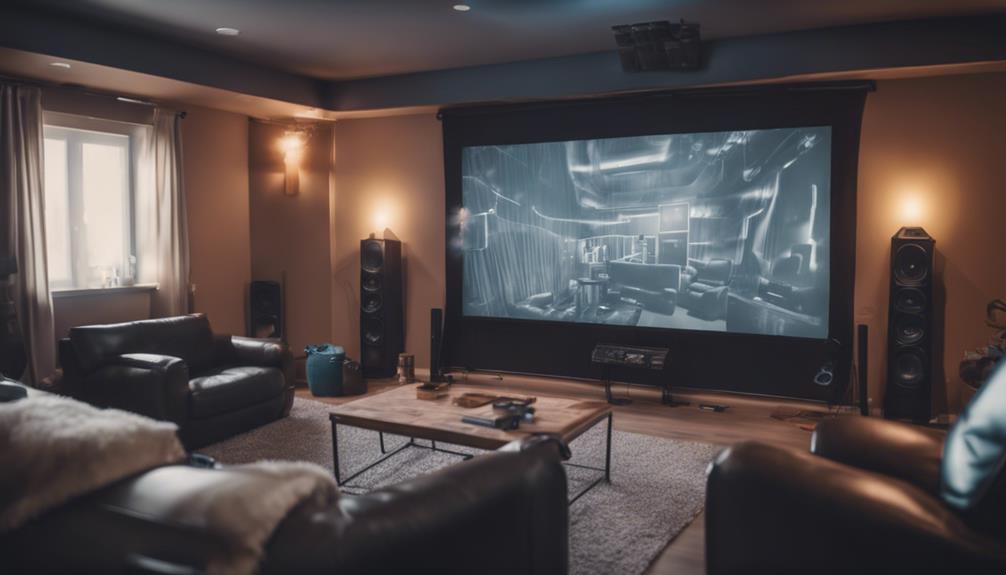
After perfecting your audio setup, it's time to focus on how to mount and install your screen for the best viewing experience. The right installation guarantees you enjoy peak comfort while watching your favorite films.
Here are some tips to take into account:
- Align with Eye Level: Position your screen 24-36 inches from the floor for ideal viewing distance.
- Ceiling Mount Projectors: Use a ceiling mount to save space and enhance sightlines, making certain to calculate the throw ratio for your desired screen size.
- Adjustable Mounting Brackets: Choose brackets that allow tilt and leveling adjustments for a properly aligned projection surface.
Always double-check for secure mounting, especially with larger screens, to prevent accidents and confirm consistent performance.
Frequently Asked Questions
How to Determine Screen Size for Home Theater?
To determine your screen size for a home theater, consider your room's dimensions and seating distance. Aim for 100 to 120 inches diagonal for a comfortable viewing experience, adjusting based on space and personal preference.
What Is the Ideal Size for a Home Cinema?
The ideal size for a home cinema typically ranges from 100 to 120 inches diagonally. This size offers an immersive experience while fitting well within standard room dimensions, enhancing your overall viewing enjoyment.
How Big Should a Cinema Screen Be?
Did you know that for best immersion, the ideal screen size is often between 100 to 120 inches? You'll want to sit 1.5 to 2.5 times the screen's diagonal size for clear viewing.
What Is the Best Size Projector Screen for Home Theater?
For the best projector screen size in your home theater, aim for 100 to 120 inches diagonally. This guarantees an immersive experience while keeping viewing comfortable and enjoyable without straining your eyes or overwhelming the space.
Conclusion
To summarize, picking the right screen size for your home cinema can greatly enhance your viewing experience.
For instance, if you have a 12-foot viewing distance, a 100-inch screen could provide the perfect balance of immersion without straining your eyes.
Remember to take into account factors like room dimensions and seating arrangements to create an ideal setup.
With the right choices, you'll transform movie nights into unforgettable cinematic adventures right in your home.
Tom is the Editor-in-Chief of 1home Theatre Projector, a website that provides news and reviews on the best home cinema experiences. With over 10 years of experience in the industry, Tom knows what makes a great home theatre projector and wants to make it easy for everyone to build the perfect setup for their needs. When he’s not busy writing or testing projectors, Tom enjoys watching classic films and spending time with his family.
